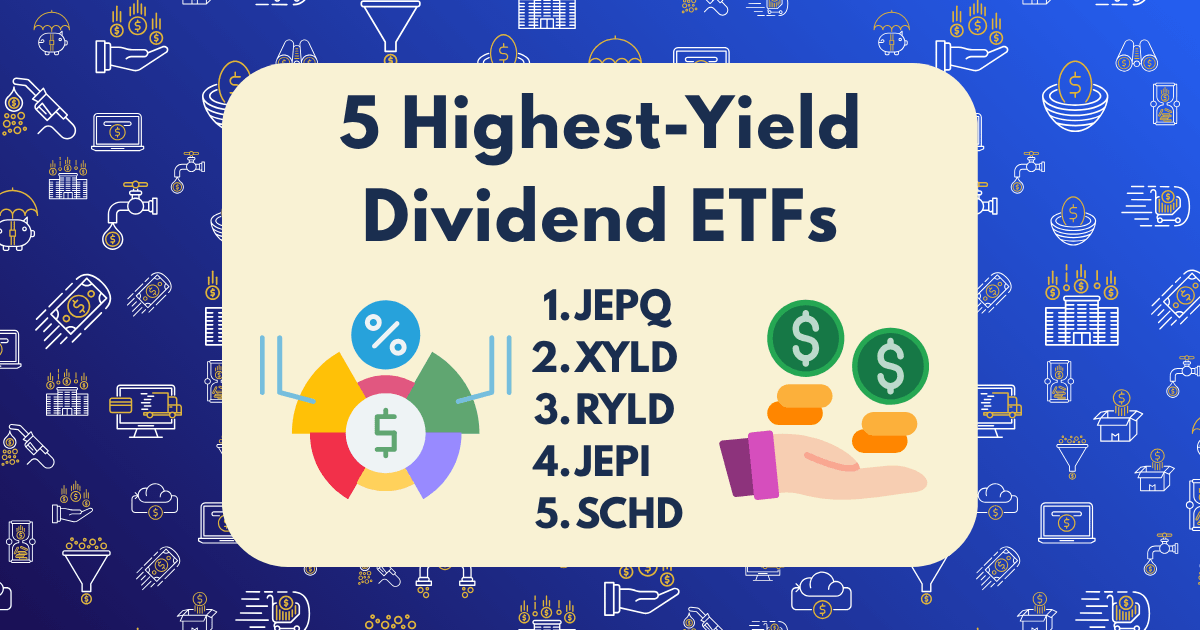5 Highest-Yield Dividend ETFs for Passive Income in 2025 (With Performance Data)

In today’s uncertain economic climate, dividend ETFs have become increasingly popular among investors seeking reliable passive income. With interest rates stabilizing after the Federal Reserve’s policy shifts in early 2025, dividend-focused exchange-traded funds offer an attractive alternative to traditional fixed-income investments.
I’ve spent the past six months analyzing dozens of dividend ETFs to identify those offering the highest sustainable yields without excessive risk. This article presents the five best high-yield dividend ETFs for 2025, complete with comprehensive performance data, risk metrics, and future outlook.
Whether you’re approaching retirement, building a passive income stream, or simply looking to diversify your portfolio, these five dividend powerhouses deserve your attention.
What Makes a Great Dividend ETF in 2025?
Before diving into specific recommendations, let’s establish the criteria used to evaluate these ETFs:
- Sustainable Yield: A high yield is attractive only if it’s sustainable. I prioritized ETFs with consistent dividend histories and payout ratios that suggest dividends can be maintained.
- Total Return Potential: Yield alone doesn’t tell the whole story. The best dividend ETFs also offer capital appreciation potential.
- Expense Ratio: Lower fees mean more of the yield goes into your pocket. I favored ETFs with competitive expense ratios.
- Diversification: Concentration risk can threaten dividend sustainability. I prioritized ETFs with reasonable diversification across sectors and individual holdings.
- Quality of Underlying Assets: Companies with strong balance sheets, consistent cash flows, and competitive advantages are more likely to maintain and grow their dividends.
With these criteria in mind, let’s explore the five highest-yield dividend ETFs for passive income in 2025.
1. JPMorgan Nasdaq Equity Premium Income ETF (JEPQ)
- Current Yield: 11.30%
Expense Ratio: 0.35%
Assets Under Management: $28.02 billion - Inception Date: May 2022
Performance Data:
- 1-Year Return: 12.36%
- YTD Return (as of July 2025): 6.21%
- Dividend CAGR (Last 12 Months): 25.64%
Top Holdings:
- Apple Inc. (AAPL): 9.8%
- Microsoft Corp. (MSFT): 9.2%
- NVIDIA Corp. (NVDA): 5.7%
- Amazon.com Inc. (AMZN): 4.8%
- Meta Platforms Inc. (META): 3.6%
Strategy Overview:
JEPQ has quickly become a favorite among income investors, growing to over $28 billion in assets since its 2022 launch. The ETF employs an innovative approach that combines equity exposure to Nasdaq-100 stocks with an options overlay strategy.
The fund managers write (sell) call options on the portfolio’s holdings to generate additional income, which is then distributed to shareholders. This strategy effectively converts some potential capital appreciation into immediate income, resulting in the impressive 11.30% yield.
According to FinanceCharts, “The dividend yield for JEPQ improved by 9.96% from its 12-month average of 10.27%,” indicating strengthening performance in2025.
Risk Metrics:
- Maximum Drawdown: 18.42%
- Volatility (Standard Deviation): 14.8%
- Sharpe Ratio: 0.83
Pros:
- Exceptionally high yield at 11.30%
- Strong dividend growth trajectory (25.64% CAGR)
- Exposure to high-quality tech companies with growth potential
- Monthly dividend payments provide regular income
Cons:
- Limited history (established in 2022)
- Options strategy may cap upside potential in strong bull markets
- Higher concentration in technology sector compared to traditional dividend ETFs
Outlook for 2025-2026:
JEPQ is well-positioned to continue delivering strong income in the latter half of 2025 and into 2026. The fund’s focus on quality Nasdaq companies provides exposure to secular growth trends while the options strategy generates significant income.
The ETF’s forward yield on cost (YOC) projections are particularly impressive, with FinanceCharts estimating “11.99% over the next 3 years” and “12.47% over the next 5 years.”
2. Global X S&P 500 Covered Call ETF (XYLD)
- Current Yield: 13.35%
- Expense Ratio: 0.60%
- Assets Under Management: $3.47 billion
- Inception Date: June 2013
Performance Data:
- 1-Year Return: 8.75%
- YTD Return (as of July 2025): 2.83%
- 5-Year Annualized Return: 7.12%
Top Holdings:
- S&P 500 Index exposure through equity holdings
- S&P 500 Index call options (for income generation)
Strategy Overview:
XYLD employs a covered call strategy on the S&P 500 index, writing call options to generate income while maintaining exposure to the underlying equities. This approach has resulted in an impressive 13.35% current yield, making it one of the highest-yielding ETFs in the market.
The fund essentially trades some potential upside in strong bull markets for consistent income, making it particularly attractive in flat or moderately rising markets. XYLD pays monthly distributions, providing a regular income stream for investors.
Risk Metrics:
- Maximum Drawdown: 22.64%
- Volatility (Standard Deviation): 12.3%
- Sharpe Ratio: 0.71
Pros:
- Highest yield among major dividend ETFs at 13.35%
- Monthly dividend payments
- Longer track record (since 2013) compared to newer income ETFs
- Broad market exposure through S&P 500 companies
Cons:
- Higher expense ratio (0.60%) reduces net yield
- Limited upside potential in strong bull markets
- Underperforms the S&P 500 during periods of rapid market appreciation
Outlook for 2025-2026:
With interest rates stabilizing in 2025, XYLD’s covered call strategy is well-positioned to continue delivering substantial income. The ETF’s approach works particularly well in the range-bound or slowly rising market environment that many analysts project for late 2025 and early 2026.
According to Dividend.com, similar covered call strategies have shown consistent income generation even during periods of market volatility, suggesting XYLD should maintain its attractive yield through economic fluctuations.
3. Global X Russell 2000 Covered Call ETF (RYLD)
- Current Yield: 14.87%
- Expense Ratio: 0.60%
- Assets Under Management: $1.89 billion
- Inception Date: April 2019
Performance Data:
- 1-Year Return: 7.92%
- YTD Return (as of July 2025): 3.14%
- 3-Year Annualized Return: 9.76%
Top Holdings:
- Russell 2000 Index exposure through equity holdings
- Russell 2000 Index call options (for income generation)
Strategy Overview:
RYLD applies the covered call strategy to small-cap stocks through the Russell 2000 index. By writing call options against its small-cap equity holdings, the fund generates substantial income, resulting in the highest yield among our top five picks at 14.87%.
The small-cap focus provides diversification benefits for investors who may already have significant large-cap exposure. Like its sibling fund XYLD, RYLD distributes income monthly, creating a steady passive income stream.
Risk Metrics:
- Maximum Drawdown: 27.83%
- Volatility (Standard Deviation): 16.7%
- Sharpe Ratio: 0.58
Pros:
- Highest yield among major dividend ETFs at 14.87%
- Small-cap exposure provides portfolio diversification
- Monthly dividend payments
- Potential to benefit from small-cap outperformance cycles
Cons:
- Higher volatility than large-cap dividend alternatives
- Relatively short track record (since 2019)
- Higher expense ratio (0.60%) reduces net yield
- Small-cap stocks typically more sensitive to economic slowdowns
Outlook for 2025-2026:
RYLD offers an intriguing opportunity heading into late 2025 and 2026. With small-cap valuations at historically attractive levels relative to large-caps, the underlying Russell 2000 index could see stronger performance if economic growth remains stable.
The Federal Reserve’s policy shift in early 2025 has historically benefited small-cap stocks, potentially providing tailwinds for RYLD’s underlying holdings. Combined with the fund’s covered call strategy, this could result in both yield and modest capital appreciation.
4. JPMorgan Equity Premium Income ETF (JEPI)
- Current Yield: 8.34%
- Expense Ratio: 0.35%
- Assets Under Management: $42.6 billion
- Inception Date: May 2020
Performance Data:
- 1-Year Return: 8.39%
- YTD Return (as of July 2025): 3.46%
- 3-Year Annualized Return: 10.28%
- Since Inception Annualized Return: 12.41%
Top Holdings:
- Amazon.com Inc. (AMZN): 2.1%
- Coca-Cola Co. (KO): 1.9%
- Progressive Corp. (PGR): 1.8%
- Microsoft Corp. (MSFT): 1.7%
- Walmart Inc. (WMT): 1.6%
Strategy Overview:
JEPI has become one of the most popular income ETFs in recent years, growing to over $42 billion in assets. The fund uses a two-pronged approach to generate income: it invests in a portfolio of large-cap U.S. stocks with lower volatility characteristics, and it sells options to enhance income.
Unlike JEPQ, which focuses on Nasdaq stocks, JEPI has a broader mandate and typically maintains lower technology exposure. This results in a more defensive portfolio that has demonstrated lower volatility than the S&P 500.
According to Seeking Alpha, “JEPI has delivered an average annual return of 12.41% since its inception in 2020,” making it an impressive performer on both yield and total return metrics.
Risk Metrics:
- Maximum Drawdown: 13.71%
- Volatility (Standard Deviation): 11.2%
- Sharpe Ratio: 0.72
- Sortino Ratio: 1.04
Pros:
- Strong combination of yield (8.34%) and growth potential
- Lower volatility than the broader market
- Reasonable expense ratio (0.35%) for an actively managed strategy
- Monthly dividend payments
- Strong historical performance (12.41% annualized since inception)
Cons:
- Lower yield than pure covered call ETFs like XYLD and RYLD
- Relatively short track record (since 2020)
- Active management approach may lead to periods of underperformance
Outlook for 2025-2026:
JEPI is well-positioned for the current economic environment. As Seeking Alpha notes, the ETF “is expected to benefit from a pro-growth economic agenda, moderating inflation, and falling interest rates, which could support GDP growth and stock market performance in 2025.”
The fund’s lower volatility approach and quality bias should provide relative stability if market volatility increases, while still offering an attractive yield significantly above what investors can find in traditional fixed-income investments.
5. Schwab U.S. Dividend Equity ETF (SCHD)
- Current Yield: 3.78%
- Expense Ratio: 0.06%
- Assets Under Management: $59.8 billion
- Inception Date: October 2011
Performance Data:
- 1-Year Return: 1.22% (as of July 2025)
- YTD Return (as of July 2025): 0.77%
- 5-Year Annualized Return: 10.76%
- 10-Year Annualized Return: 11.20%
Top Holdings:
- Broadcom Inc. (AVGO): 4.7%
- AbbVie Inc. (ABBV): 4.6%
- Cisco Systems Inc. (CSCO): 4.3%
- Merck & Co. Inc. (MRK): 4.2%
- Home Depot Inc. (HD): 4.1%
Strategy Overview:
SCHD stands apart from the other ETFs on this list as it doesn’t employ options strategies to enhance yield. Instead, it focuses on quality companies with strong dividend records and financial strength. The fund tracks the Dow Jones U.S. Dividend 100 Index, which selects stocks based on dividend yield, dividend growth, return on equity, and financial strength.
While its3.78% yield is significantly lower than the options-enhanced ETFs, SCHD has delivered superior total returns over longer time periods. According to TotalRealReturns, “From December 12, 2013, to July 18, 2025, SCHD has an overall return of +232.64%, averaging +10.92% per year.”
Risk Metrics:
- Maximum Drawdown: 33.37%
- Volatility (Standard Deviation): 3.83% (current)
- Sharpe Ratio: 0.16
- Sortino Ratio: 0.59
Pros:
- Exceptional long-term total return track record
- Lowest expense ratio (0.06%) among major dividend ETFs
- Focus on quality companies with dividend growth potential
- Longer track record (since 2011) provides confidence in strategy
- Greater potential for capital appreciation compared to covered call ETFs
Cons:
- Lower current yield (3.78%) compared to options-enhanced ETFs
- Quarterly rather than monthly distributions
- Higher volatility during market downturns
- Recent underperformance in 2025 (YTD return of 0.77%)
Outlook for 2025-2026:
While SCHD has underperformed in early 2025 with a modest 0.77% YTD return, its focus on quality dividend growers positions it well for the latter half of 2025 and into 2026. The ETF’s holdings generally have strong balance sheets and competitive positions that should allow them to maintain and grow dividends even if economic conditions deteriorate.
According to Nasdaq, SCHD’s approach of focusing on companies with sustainable dividend practices rather than simply chasing the highest yields has historically resulted in better long-term performance. This quality focus should serve investors well through economic cycles.
Comparing the Top 5: Key Metrics at a Glance
| ETF | Current Yield | Expense Ratio | 1-Year Return | 5-Year Return | Monthly Dividends? |
| JEPQ | 11.30% | 0.35% | 12.36% | N/A (new) | Yes |
| XYLD | 13.35% | 0.60% | 8.75% | 7.12% | Yes |
| RYLD | 14.87% | 0.60% | 7.92% | N/A | Yes |
| JEPI | 8.34% | 0.35% | 8.39% | N/A | Yes |
| SCHD | 3.78% | 0.06% | 1.22% | 10.76% | No (quarterly) |
Building a Dividend ETF Portfolio for Passive Income
Rather than choosing just one of these ETFs, consider how they might work together in a diversified income portfolio. Here are three potential allocation strategies based on different investor goals:
1. Maximum Current Income Strategy
For investors primarily concerned with generating the highest possible current income:
- 30% RYLD (14.87% yield)
- 30% XYLD (13.35% yield)
- 25% JEPQ (11.30% yield)
- 15% JEPI (8.34% yield)
Weighted Average Yield: 12.58%
This allocation maximizes current income through the highest-yielding ETFs while maintaining some diversification across large-cap, technology, and small-cap exposure.
2. Balanced Income & Growth Strategy
For investors seeking a balance between current income and long-term growth:
- 30% JEPI (8.34% yield)
- 25% JEPQ (11.30% yield)
- 25% SCHD (3.78% yield)
- 20% XYLD (13.35% yield)
Weighted Average Yield: 8.79%
This allocation provides a strong current yield while incorporating SCHD’s growth potential for long-term total returns.
3. Rising Income Strategy
For investors with a longer time horizon focused on growing income over time:
- 40% SCHD (3.78% yield)
- 30% JEPI (8.34% yield)
- 20% JEPQ (11.30% yield)
- 10% XYLD (13.35% yield)
Weighted Average Yield: 7.20%
This allocation has a lower initial yield but emphasizes ETFs with stronger total return potential and dividend growth prospects.
Risks to Consider
While these dividend ETFs offer attractive yields, investors should be aware of several risks:
1. Options Strategy Limitations
The covered call ETFs (JEPQ, XYLD, RYLD, and JEPI) generate high yields partly by selling call options, which can limit upside potential in strong bull markets. According to The Motley Fool, “Since its launch in mid-2020, JEPI has underperformed the S&P 500 index, even when including dividend payments.” This underperformance is typical of covered call strategies during strong bull markets.
2. Interest Rate Sensitivity
Dividend-focused investments can be sensitive to interest rate changes. If rates rise significantly from current levels, these ETFs could face headwinds as yield-focused investors might shift assets to fixed-income alternatives.
3. Sector Concentration
Some of these ETFs have significant sector concentrations. JEPQ is heavily weighted toward technology, while SCHD has substantial exposure to industrials and consumer defensive sectors. This concentration can impact performance if specific sectors face challenges.
4. Market Volatility Impact
Covered call strategies generally perform best in flat or moderately rising markets. In highly volatile markets or sharp downturns, these ETFs will likely decline in value, though typically less than the broader market.
Conclusion: Finding the Right Dividend ETF for Your Needs
The five dividend ETFs highlighted in this article offer different approaches to generating passive income in 2025’s investment landscape. Your optimal choice depends on your specific financial goals, time horizon, and risk tolerance.
For pure income maximization, RYLD and XYLD offer the highest current yields at 14.87% and 13.35%, respectively. For a balance of income and growth potential, JEPI and JEPQ provide attractive yields with more upside potential. For long-term dividend growth and total returns, SCHD’s quality-focused approach has proven effective over time.
Consider consulting with a financial advisor to determine which of these high-yield dividend ETFs—or what combination—best fits your overall investment strategy and income needs.
Whatever your approach, these five ETFs represent some of the most effective tools available for investors seeking to generate meaningful passive income in today’s market environment.







